Financial Management Project Report: Time Value of Money Analysis
VerifiedAdded on 2020/05/28
|10
|1526
|41
Project
AI Summary
This project report delves into the core concepts of financial management, specifically focusing on the time value of money. It explores calculations for both single and multiple cash flows, examining future and present values under various interest rates and compounding periods. The report includes detailed analyses of annuities and perpetuities, providing practical examples and calculations to illustrate their impact on financial decisions. The report also includes references to academic resources. The project highlights the significance of compounding frequency and discount rates in determining the present and future values of investments, offering insights into optimal financial strategies. This project report is a valuable resource for students seeking to understand and apply the fundamental principles of financial management.
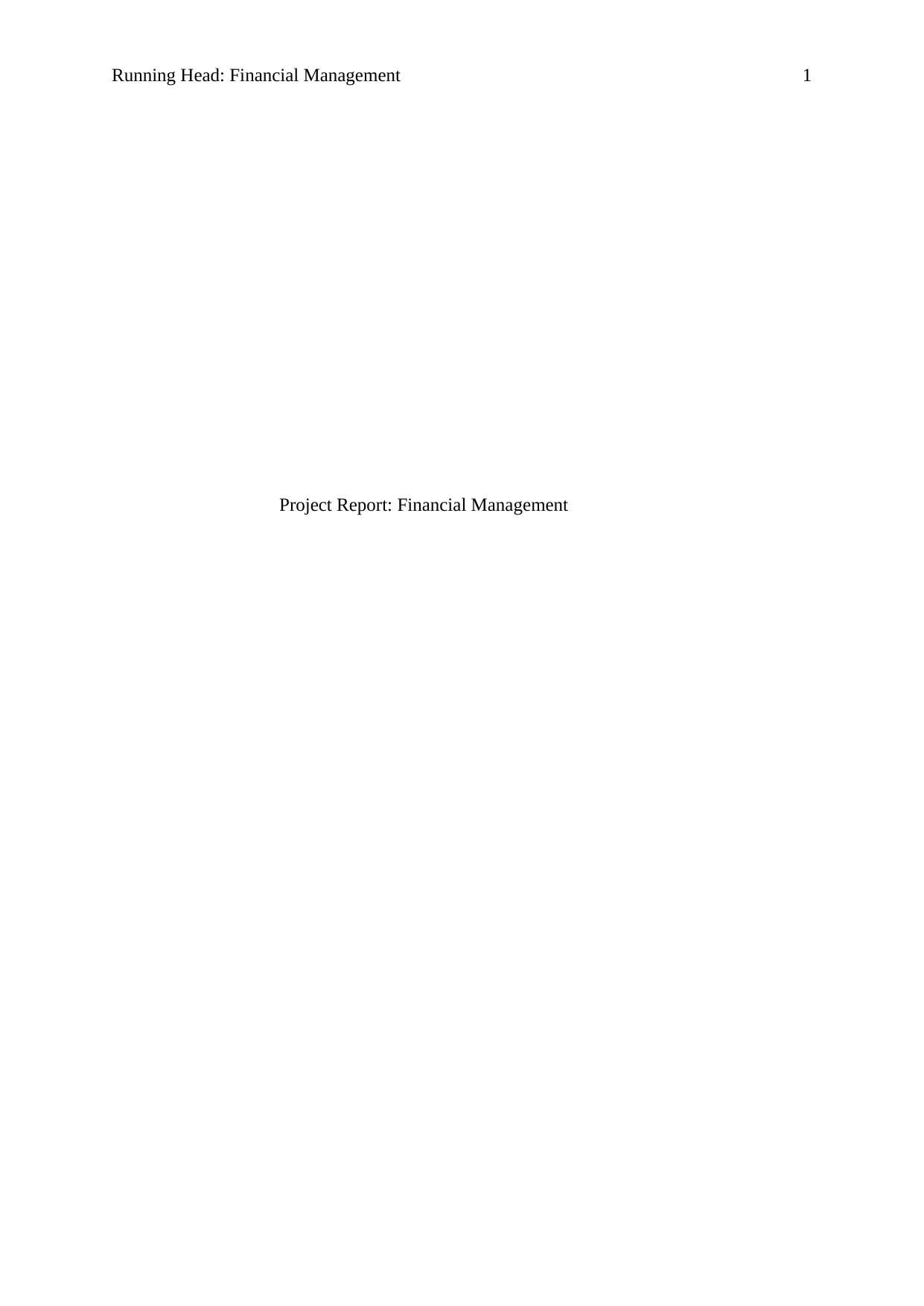
Running Head: Financial Management 1
Project Report: Financial Management
Project Report: Financial Management
Paraphrase This Document
Need a fresh take? Get an instant paraphrase of this document with our AI Paraphraser
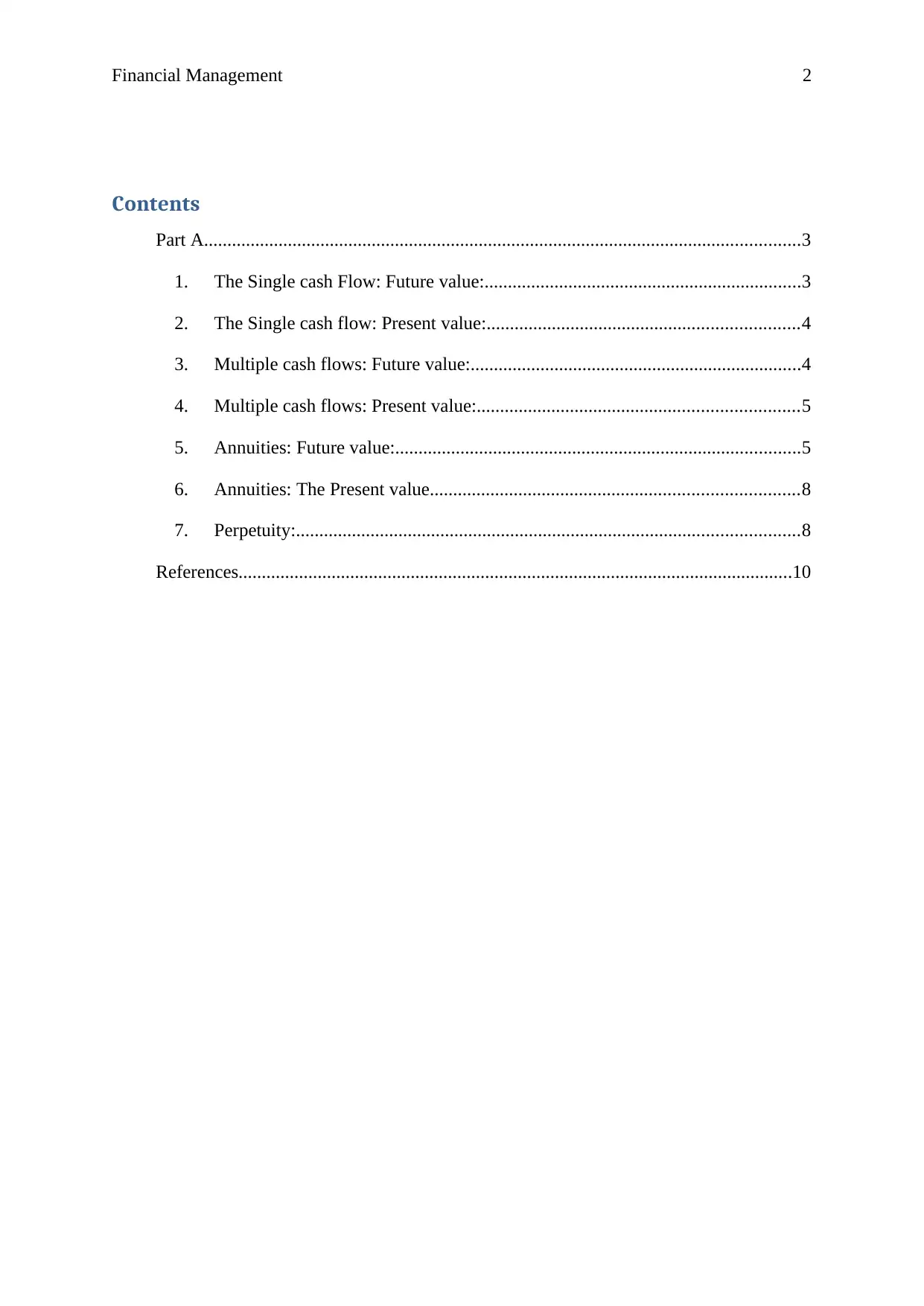
Financial Management 2
Contents
Part A................................................................................................................................3
1. The Single cash Flow: Future value:....................................................................3
2. The Single cash flow: Present value:...................................................................4
3. Multiple cash flows: Future value:.......................................................................4
4. Multiple cash flows: Present value:.....................................................................5
5. Annuities: Future value:.......................................................................................5
6. Annuities: The Present value...............................................................................8
7. Perpetuity:............................................................................................................8
References.......................................................................................................................10
Contents
Part A................................................................................................................................3
1. The Single cash Flow: Future value:....................................................................3
2. The Single cash flow: Present value:...................................................................4
3. Multiple cash flows: Future value:.......................................................................4
4. Multiple cash flows: Present value:.....................................................................5
5. Annuities: Future value:.......................................................................................5
6. Annuities: The Present value...............................................................................8
7. Perpetuity:............................................................................................................8
References.......................................................................................................................10
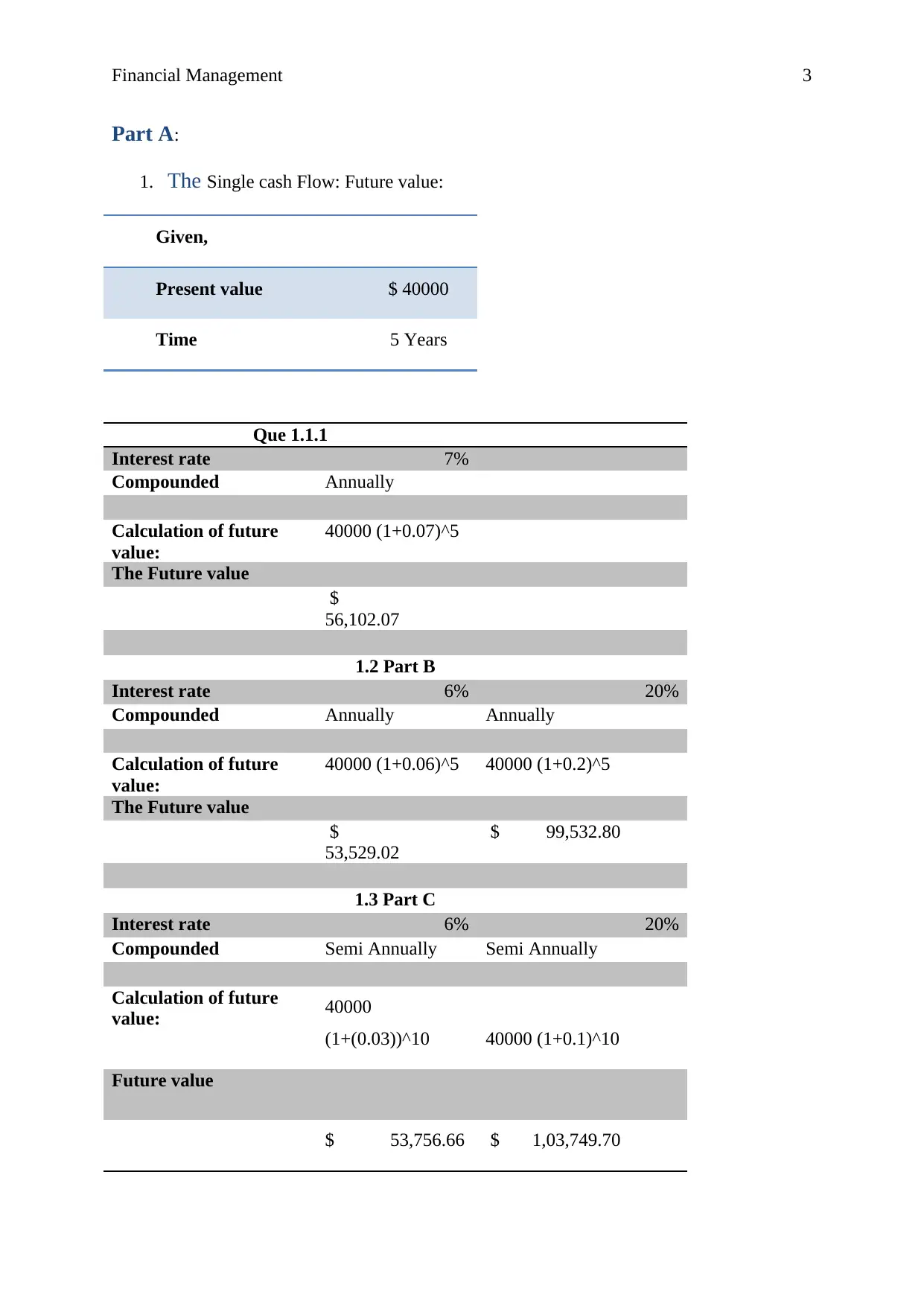
Financial Management 3
Part A:
1. The Single cash Flow: Future value:
Given,
Present value $ 40000
Time 5 Years
Que 1.1.1
Interest rate 7%
Compounded Annually
Calculation of future
value:
40000 (1+0.07)^5
The Future value
$
56,102.07
1.2 Part B
Interest rate 6% 20%
Compounded Annually Annually
Calculation of future
value:
40000 (1+0.06)^5 40000 (1+0.2)^5
The Future value
$
53,529.02
$ 99,532.80
1.3 Part C
Interest rate 6% 20%
Compounded Semi Annually Semi Annually
Calculation of future
value: 40000
(1+(0.03))^10 40000 (1+0.1)^10
Future value
$ 53,756.66 $ 1,03,749.70
Part A:
1. The Single cash Flow: Future value:
Given,
Present value $ 40000
Time 5 Years
Que 1.1.1
Interest rate 7%
Compounded Annually
Calculation of future
value:
40000 (1+0.07)^5
The Future value
$
56,102.07
1.2 Part B
Interest rate 6% 20%
Compounded Annually Annually
Calculation of future
value:
40000 (1+0.06)^5 40000 (1+0.2)^5
The Future value
$
53,529.02
$ 99,532.80
1.3 Part C
Interest rate 6% 20%
Compounded Semi Annually Semi Annually
Calculation of future
value: 40000
(1+(0.03))^10 40000 (1+0.1)^10
Future value
$ 53,756.66 $ 1,03,749.70
⊘ This is a preview!⊘
Do you want full access?
Subscribe today to unlock all pages.

Trusted by 1+ million students worldwide
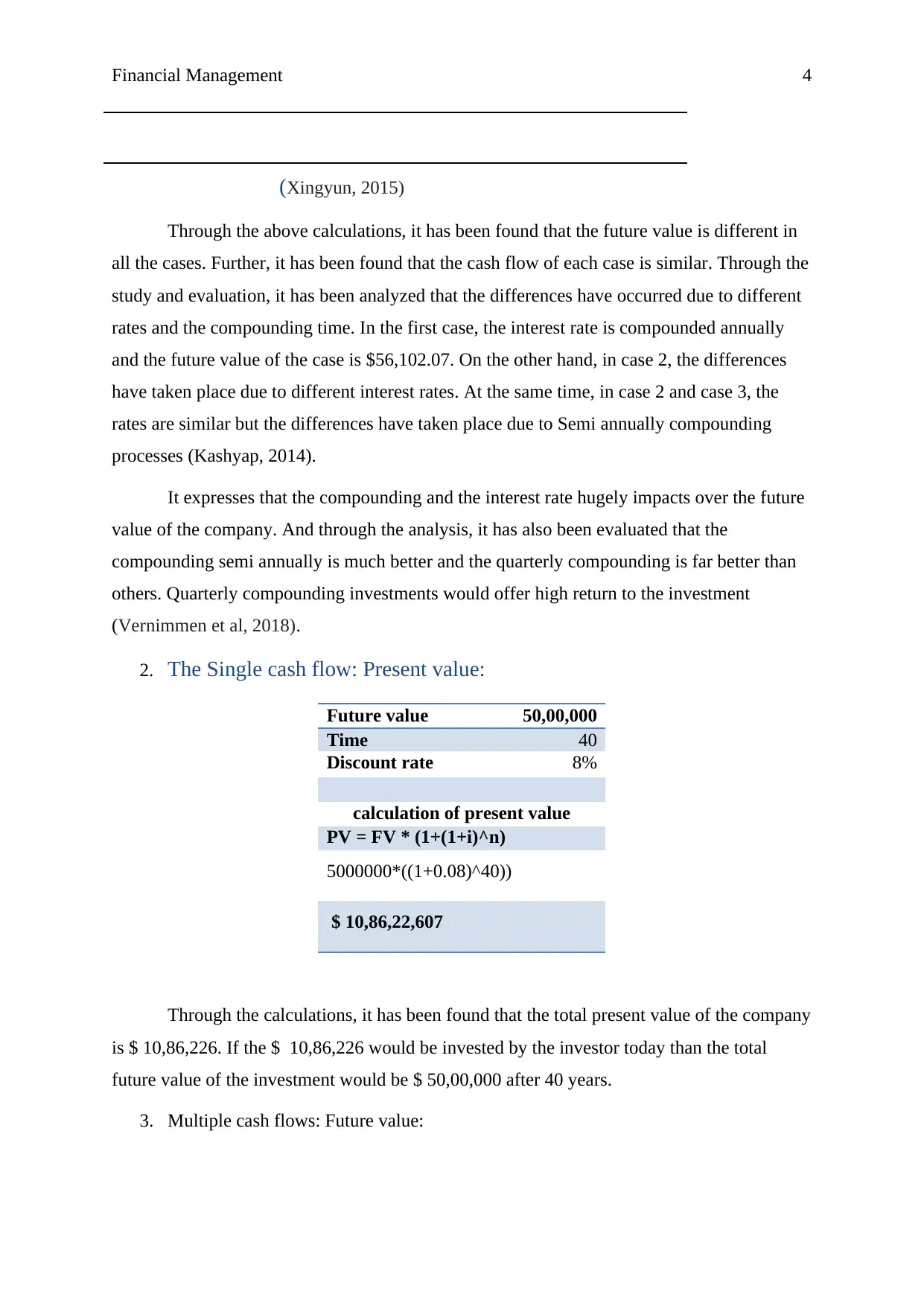
Financial Management 4
(Xingyun, 2015)
Through the above calculations, it has been found that the future value is different in
all the cases. Further, it has been found that the cash flow of each case is similar. Through the
study and evaluation, it has been analyzed that the differences have occurred due to different
rates and the compounding time. In the first case, the interest rate is compounded annually
and the future value of the case is $56,102.07. On the other hand, in case 2, the differences
have taken place due to different interest rates. At the same time, in case 2 and case 3, the
rates are similar but the differences have taken place due to Semi annually compounding
processes (Kashyap, 2014).
It expresses that the compounding and the interest rate hugely impacts over the future
value of the company. And through the analysis, it has also been evaluated that the
compounding semi annually is much better and the quarterly compounding is far better than
others. Quarterly compounding investments would offer high return to the investment
(Vernimmen et al, 2018).
2. The Single cash flow: Present value:
Future value 50,00,000
Time 40
Discount rate 8%
calculation of present value
PV = FV * (1+(1+i)^n)
5000000*((1+0.08)^40))
$ 10,86,22,607
Through the calculations, it has been found that the total present value of the company
is $ 10,86,226. If the $ 10,86,226 would be invested by the investor today than the total
future value of the investment would be $ 50,00,000 after 40 years.
3. Multiple cash flows: Future value:
(Xingyun, 2015)
Through the above calculations, it has been found that the future value is different in
all the cases. Further, it has been found that the cash flow of each case is similar. Through the
study and evaluation, it has been analyzed that the differences have occurred due to different
rates and the compounding time. In the first case, the interest rate is compounded annually
and the future value of the case is $56,102.07. On the other hand, in case 2, the differences
have taken place due to different interest rates. At the same time, in case 2 and case 3, the
rates are similar but the differences have taken place due to Semi annually compounding
processes (Kashyap, 2014).
It expresses that the compounding and the interest rate hugely impacts over the future
value of the company. And through the analysis, it has also been evaluated that the
compounding semi annually is much better and the quarterly compounding is far better than
others. Quarterly compounding investments would offer high return to the investment
(Vernimmen et al, 2018).
2. The Single cash flow: Present value:
Future value 50,00,000
Time 40
Discount rate 8%
calculation of present value
PV = FV * (1+(1+i)^n)
5000000*((1+0.08)^40))
$ 10,86,22,607
Through the calculations, it has been found that the total present value of the company
is $ 10,86,226. If the $ 10,86,226 would be invested by the investor today than the total
future value of the investment would be $ 50,00,000 after 40 years.
3. Multiple cash flows: Future value:
Paraphrase This Document
Need a fresh take? Get an instant paraphrase of this document with our AI Paraphraser
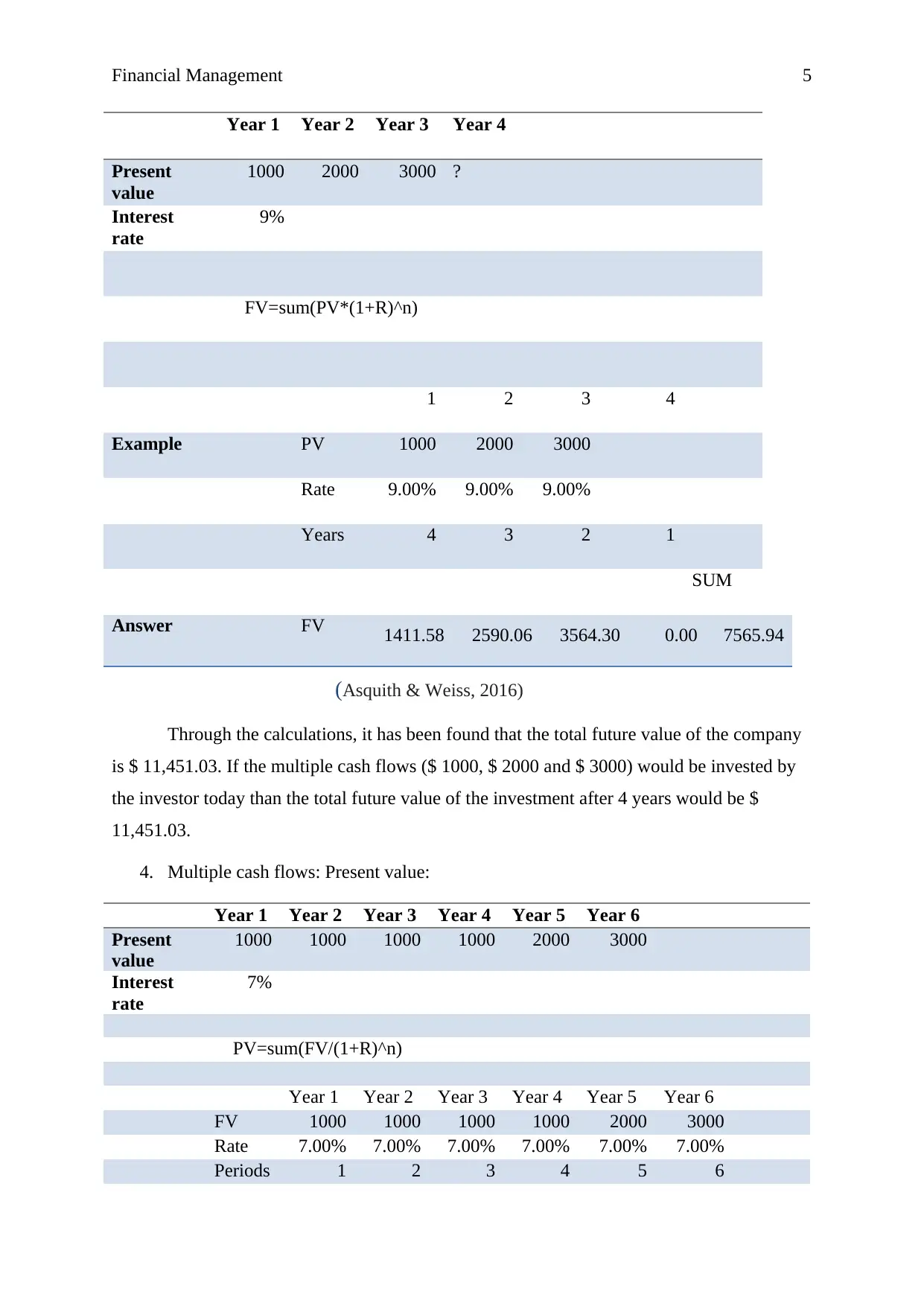
Financial Management 5
Year 1 Year 2 Year 3 Year 4
Present
value
1000 2000 3000 ?
Interest
rate
9%
FV=sum(PV*(1+R)^n)
1 2 3 4
Example PV 1000 2000 3000
Rate 9.00% 9.00% 9.00%
Years 4 3 2 1
SUM
Answer FV 1411.58 2590.06 3564.30 0.00 7565.94
(Asquith & Weiss, 2016)
Through the calculations, it has been found that the total future value of the company
is $ 11,451.03. If the multiple cash flows ($ 1000, $ 2000 and $ 3000) would be invested by
the investor today than the total future value of the investment after 4 years would be $
11,451.03.
4. Multiple cash flows: Present value:
Year 1 Year 2 Year 3 Year 4 Year 5 Year 6
Present
value
1000 1000 1000 1000 2000 3000
Interest
rate
7%
PV=sum(FV/(1+R)^n)
Year 1 Year 2 Year 3 Year 4 Year 5 Year 6
FV 1000 1000 1000 1000 2000 3000
Rate 7.00% 7.00% 7.00% 7.00% 7.00% 7.00%
Periods 1 2 3 4 5 6
Year 1 Year 2 Year 3 Year 4
Present
value
1000 2000 3000 ?
Interest
rate
9%
FV=sum(PV*(1+R)^n)
1 2 3 4
Example PV 1000 2000 3000
Rate 9.00% 9.00% 9.00%
Years 4 3 2 1
SUM
Answer FV 1411.58 2590.06 3564.30 0.00 7565.94
(Asquith & Weiss, 2016)
Through the calculations, it has been found that the total future value of the company
is $ 11,451.03. If the multiple cash flows ($ 1000, $ 2000 and $ 3000) would be invested by
the investor today than the total future value of the investment after 4 years would be $
11,451.03.
4. Multiple cash flows: Present value:
Year 1 Year 2 Year 3 Year 4 Year 5 Year 6
Present
value
1000 1000 1000 1000 2000 3000
Interest
rate
7%
PV=sum(FV/(1+R)^n)
Year 1 Year 2 Year 3 Year 4 Year 5 Year 6
FV 1000 1000 1000 1000 2000 3000
Rate 7.00% 7.00% 7.00% 7.00% 7.00% 7.00%
Periods 1 2 3 4 5 6
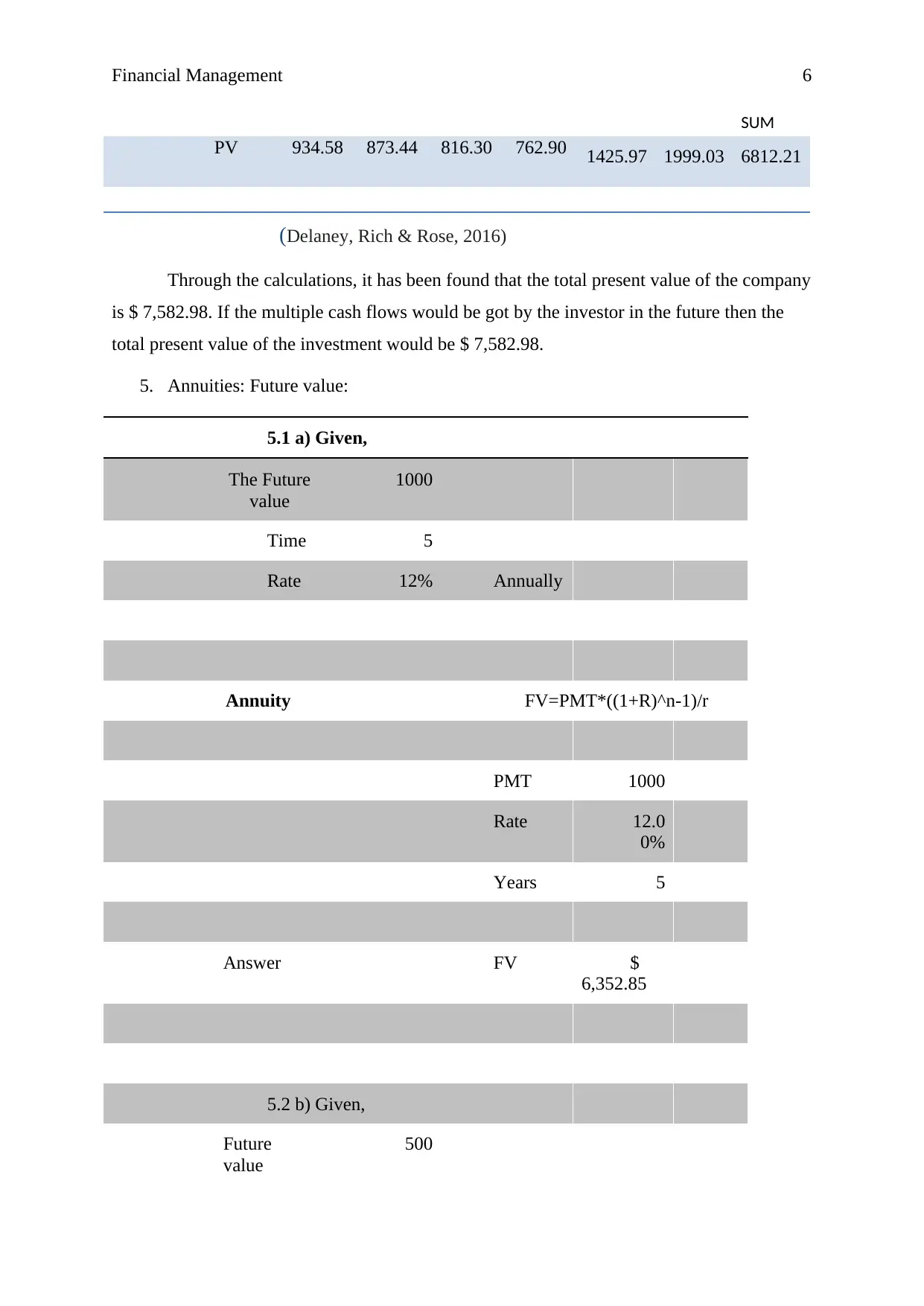
Financial Management 6
SUM
PV 934.58 873.44 816.30 762.90 1425.97 1999.03 6812.21
(Delaney, Rich & Rose, 2016)
Through the calculations, it has been found that the total present value of the company
is $ 7,582.98. If the multiple cash flows would be got by the investor in the future then the
total present value of the investment would be $ 7,582.98.
5. Annuities: Future value:
5.1 a) Given,
The Future
value
1000
Time 5
Rate 12% Annually
Annuity FV=PMT*((1+R)^n-1)/r
PMT 1000
Rate 12.0
0%
Years 5
Answer FV $
6,352.85
5.2 b) Given,
Future
value
500
SUM
PV 934.58 873.44 816.30 762.90 1425.97 1999.03 6812.21
(Delaney, Rich & Rose, 2016)
Through the calculations, it has been found that the total present value of the company
is $ 7,582.98. If the multiple cash flows would be got by the investor in the future then the
total present value of the investment would be $ 7,582.98.
5. Annuities: Future value:
5.1 a) Given,
The Future
value
1000
Time 5
Rate 12% Annually
Annuity FV=PMT*((1+R)^n-1)/r
PMT 1000
Rate 12.0
0%
Years 5
Answer FV $
6,352.85
5.2 b) Given,
Future
value
500
⊘ This is a preview!⊘
Do you want full access?
Subscribe today to unlock all pages.

Trusted by 1+ million students worldwide

Financial Management 7
Time 10
Rate 6% Semi annually
Annuity FV=PMT*((1+R)^n-1)/r
PMT 500
Rate 6.00
%
Years 10
Answer FV $
6,590.40
5.3 c) Given,
The Future
value
250
Time 20
Rate 3% Quarterl
y
Annuity FV=PMT*((1+R)^n-1)/r
PMT 250
Rate 3.00
%
Years 20
Time 10
Rate 6% Semi annually
Annuity FV=PMT*((1+R)^n-1)/r
PMT 500
Rate 6.00
%
Years 10
Answer FV $
6,590.40
5.3 c) Given,
The Future
value
250
Time 20
Rate 3% Quarterl
y
Annuity FV=PMT*((1+R)^n-1)/r
PMT 250
Rate 3.00
%
Years 20
Paraphrase This Document
Need a fresh take? Get an instant paraphrase of this document with our AI Paraphraser
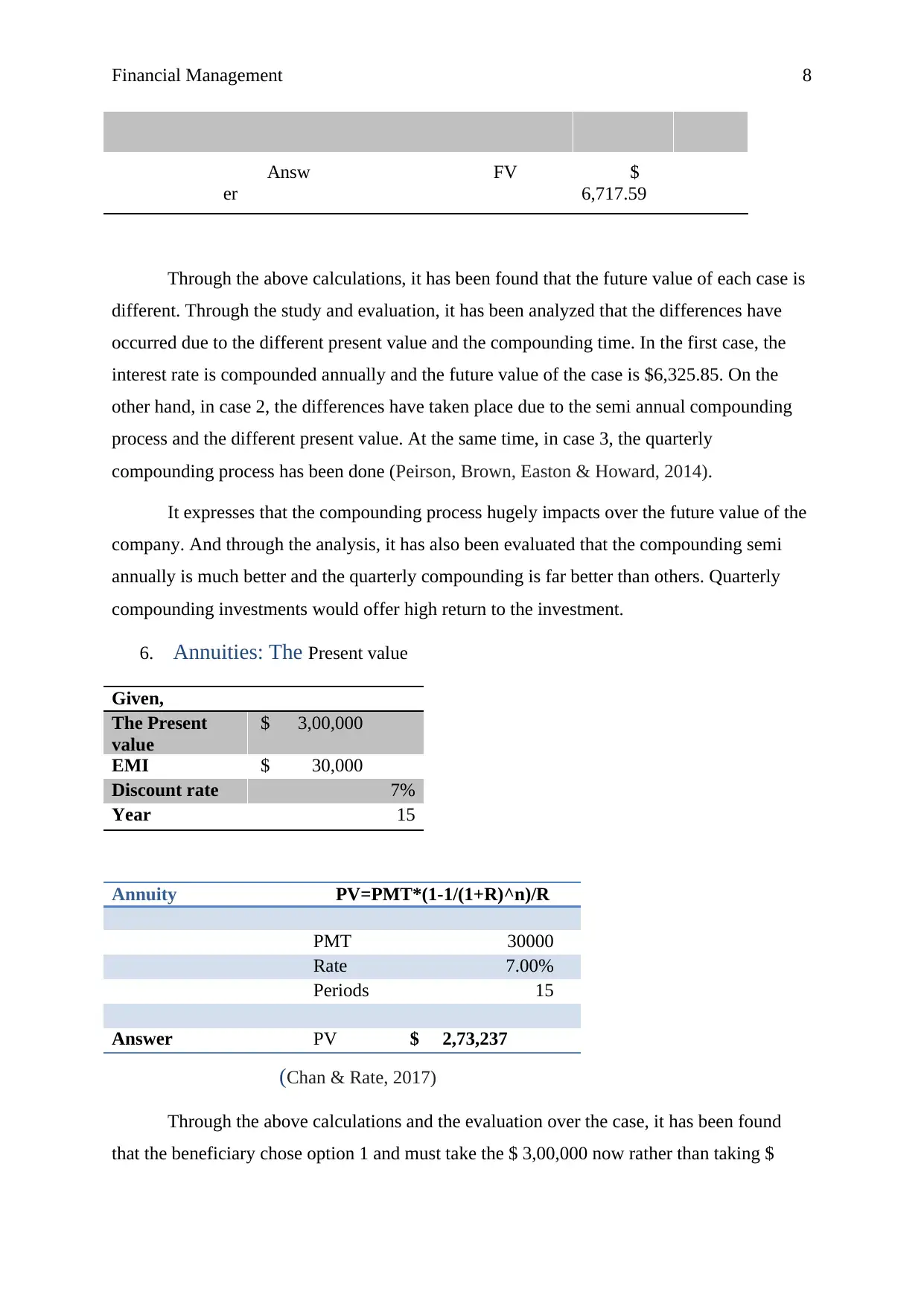
Financial Management 8
Answ
er
FV $
6,717.59
Through the above calculations, it has been found that the future value of each case is
different. Through the study and evaluation, it has been analyzed that the differences have
occurred due to the different present value and the compounding time. In the first case, the
interest rate is compounded annually and the future value of the case is $6,325.85. On the
other hand, in case 2, the differences have taken place due to the semi annual compounding
process and the different present value. At the same time, in case 3, the quarterly
compounding process has been done (Peirson, Brown, Easton & Howard, 2014).
It expresses that the compounding process hugely impacts over the future value of the
company. And through the analysis, it has also been evaluated that the compounding semi
annually is much better and the quarterly compounding is far better than others. Quarterly
compounding investments would offer high return to the investment.
6. Annuities: The Present value
Given,
The Present
value
$ 3,00,000
EMI $ 30,000
Discount rate 7%
Year 15
Annuity PV=PMT*(1-1/(1+R)^n)/R
PMT 30000
Rate 7.00%
Periods 15
Answer PV $ 2,73,237
(Chan & Rate, 2017)
Through the above calculations and the evaluation over the case, it has been found
that the beneficiary chose option 1 and must take the $ 3,00,000 now rather than taking $
Answ
er
FV $
6,717.59
Through the above calculations, it has been found that the future value of each case is
different. Through the study and evaluation, it has been analyzed that the differences have
occurred due to the different present value and the compounding time. In the first case, the
interest rate is compounded annually and the future value of the case is $6,325.85. On the
other hand, in case 2, the differences have taken place due to the semi annual compounding
process and the different present value. At the same time, in case 3, the quarterly
compounding process has been done (Peirson, Brown, Easton & Howard, 2014).
It expresses that the compounding process hugely impacts over the future value of the
company. And through the analysis, it has also been evaluated that the compounding semi
annually is much better and the quarterly compounding is far better than others. Quarterly
compounding investments would offer high return to the investment.
6. Annuities: The Present value
Given,
The Present
value
$ 3,00,000
EMI $ 30,000
Discount rate 7%
Year 15
Annuity PV=PMT*(1-1/(1+R)^n)/R
PMT 30000
Rate 7.00%
Periods 15
Answer PV $ 2,73,237
(Chan & Rate, 2017)
Through the above calculations and the evaluation over the case, it has been found
that the beneficiary chose option 1 and must take the $ 3,00,000 now rather than taking $

Financial Management 9
30,000 at the end of every year. It explains that the total future value of this case would be $
2,73,237 which is quite lower than the present value.
7. Perpetuity:
7.1 Perpetuity PV=PMT*(1/r)
PMT 1000
Rate 6.00%
Years NA
Answer PV 16666.7
Through the above calculations, it has been found that the present value
of this case is $ 16,667.
7.2 Perpetuity PV=PMT*(1/r)
PMT “1000”
Rate 12.00%
Years NA
Answer PV 8333.33
Further, through the above calculations, it has been found that the present value of this
case is $ 8333.33 which explains that the discount rate have impacted over the present value
of the company a lot. More, amount would be required by the company to manage the
perpetuity.
30,000 at the end of every year. It explains that the total future value of this case would be $
2,73,237 which is quite lower than the present value.
7. Perpetuity:
7.1 Perpetuity PV=PMT*(1/r)
PMT 1000
Rate 6.00%
Years NA
Answer PV 16666.7
Through the above calculations, it has been found that the present value
of this case is $ 16,667.
7.2 Perpetuity PV=PMT*(1/r)
PMT “1000”
Rate 12.00%
Years NA
Answer PV 8333.33
Further, through the above calculations, it has been found that the present value of this
case is $ 8333.33 which explains that the discount rate have impacted over the present value
of the company a lot. More, amount would be required by the company to manage the
perpetuity.
⊘ This is a preview!⊘
Do you want full access?
Subscribe today to unlock all pages.

Trusted by 1+ million students worldwide
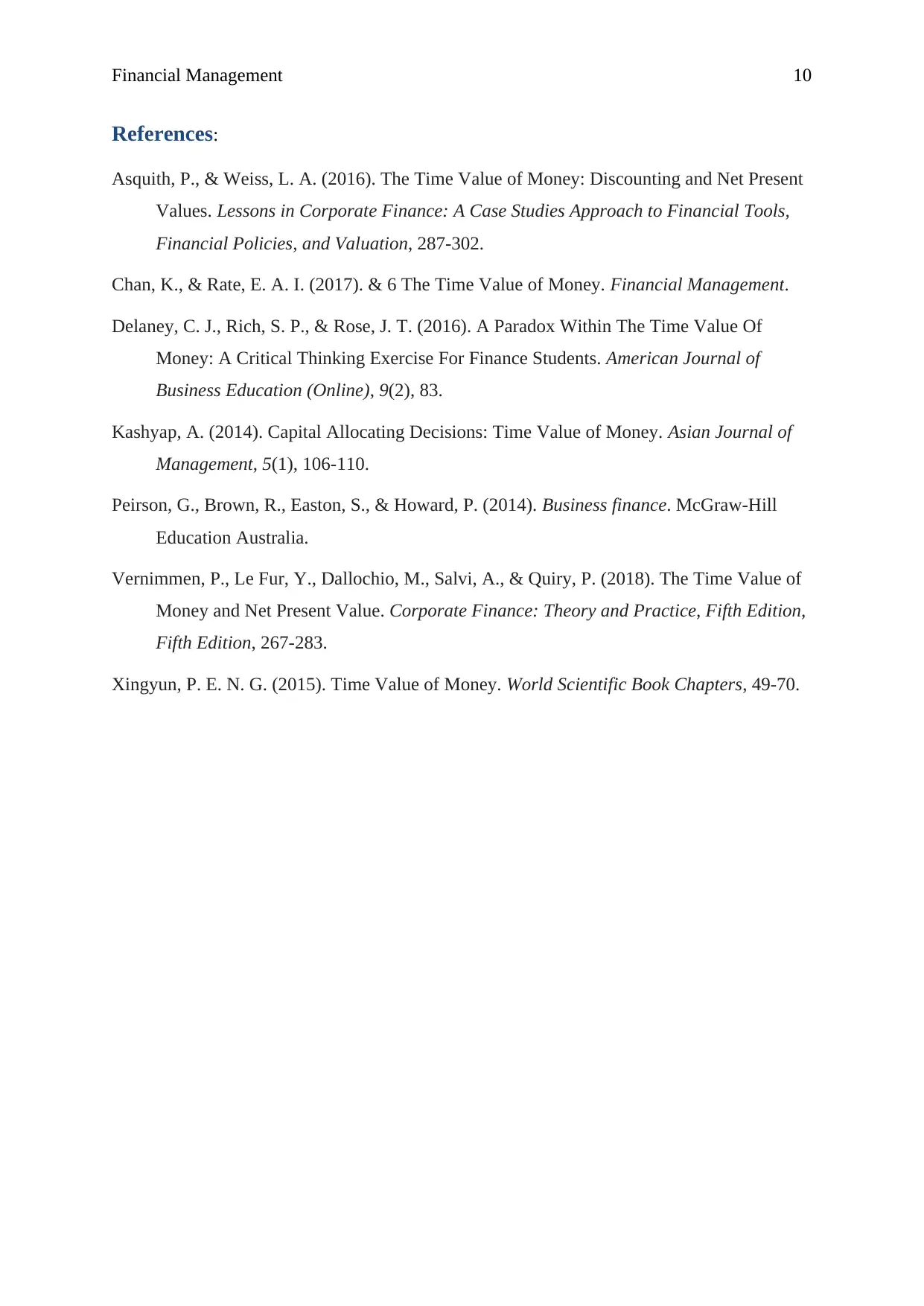
Financial Management 10
References:
Asquith, P., & Weiss, L. A. (2016). The Time Value of Money: Discounting and Net Present
Values. Lessons in Corporate Finance: A Case Studies Approach to Financial Tools,
Financial Policies, and Valuation, 287-302.
Chan, K., & Rate, E. A. I. (2017). & 6 The Time Value of Money. Financial Management.
Delaney, C. J., Rich, S. P., & Rose, J. T. (2016). A Paradox Within The Time Value Of
Money: A Critical Thinking Exercise For Finance Students. American Journal of
Business Education (Online), 9(2), 83.
Kashyap, A. (2014). Capital Allocating Decisions: Time Value of Money. Asian Journal of
Management, 5(1), 106-110.
Peirson, G., Brown, R., Easton, S., & Howard, P. (2014). Business finance. McGraw-Hill
Education Australia.
Vernimmen, P., Le Fur, Y., Dallochio, M., Salvi, A., & Quiry, P. (2018). The Time Value of
Money and Net Present Value. Corporate Finance: Theory and Practice, Fifth Edition,
Fifth Edition, 267-283.
Xingyun, P. E. N. G. (2015). Time Value of Money. World Scientific Book Chapters, 49-70.
References:
Asquith, P., & Weiss, L. A. (2016). The Time Value of Money: Discounting and Net Present
Values. Lessons in Corporate Finance: A Case Studies Approach to Financial Tools,
Financial Policies, and Valuation, 287-302.
Chan, K., & Rate, E. A. I. (2017). & 6 The Time Value of Money. Financial Management.
Delaney, C. J., Rich, S. P., & Rose, J. T. (2016). A Paradox Within The Time Value Of
Money: A Critical Thinking Exercise For Finance Students. American Journal of
Business Education (Online), 9(2), 83.
Kashyap, A. (2014). Capital Allocating Decisions: Time Value of Money. Asian Journal of
Management, 5(1), 106-110.
Peirson, G., Brown, R., Easton, S., & Howard, P. (2014). Business finance. McGraw-Hill
Education Australia.
Vernimmen, P., Le Fur, Y., Dallochio, M., Salvi, A., & Quiry, P. (2018). The Time Value of
Money and Net Present Value. Corporate Finance: Theory and Practice, Fifth Edition,
Fifth Edition, 267-283.
Xingyun, P. E. N. G. (2015). Time Value of Money. World Scientific Book Chapters, 49-70.
1 out of 10
Related Documents
Your All-in-One AI-Powered Toolkit for Academic Success.
+13062052269
info@desklib.com
Available 24*7 on WhatsApp / Email
![[object Object]](/_next/static/media/star-bottom.7253800d.svg)
Unlock your academic potential
Copyright © 2020–2025 A2Z Services. All Rights Reserved. Developed and managed by ZUCOL.





